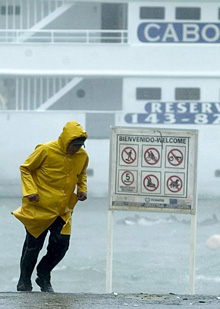 |
 |
 |
 News from Around the Americas | September 2007 News from Around the Americas | September 2007  
Storms Blow Into Record Books
 Paul Kiernan - Associated Press Paul Kiernan - Associated Press
go to original


| | A man struggles Tuesday as Hurricane Henriette lashes Cabo San Lucas, Mexico. (Associated Press) |
Cabo San Lucas, Mexico - Felix and Henriette made hurricane history Tuesday.

Eight hours after Felix roared into Central America, Henriette slammed into the resort-studded tip of the Baja California peninsula. Never before had an Atlantic and a Pacific hurricane made landfall on the same date.

It also was the first time on record that two Category 5 Atlantic hurricanes made landfall in the same year, with Felix hitting two weeks after monstrous Hurricane Dean plowed into southern Mexico.

Felix is the 31st Category 5 hurricane seen in the Atlantic since record-keeping began in 1886 - and the eighth in the past five seasons.

Some scientists think technological advances simply have made hurricane measurements more accurate. Others see the surge of powerful storms as a sign of global warming.

"Today hurricanes are becoming increasingly violent. For example, water from the Caribbean, the ocean, is two degrees hotter than before," Mexican President Felipe Calderon said, siding with a growing number of climate-change experts. "This makes steam rise off the ocean more quickly; hurricanes form faster and are more violent."

Dr. Chris Landsea, science operations officer at the U.S. National Hurricane Center, agreed that global warming is a factor, but only a small one.

"All of the studies suggest that by the end of this century, hurricanes may become stronger by 5 percent because of global warming. So a 100 miles per hour hurricane would be 105 miles per hour," Landsea said. "Most of what we're seeing is natural fluctuations."

While weakening rapidly, Felix's rains posed a danger to inland villages and urban shantytowns.

Felix roared ashore before dawn as a Category 5 storm along Nicaragua's remote northeast corner. The 160-mph winds peeled roofs off shelters and a police station, knocked down electric poles and stripped humble homes to a few walls.

By Tuesday evening, Felix had weakened to a Category 1 storm with winds of 80 mph. But forecasters still were worried that the tempest would do great damage inland over Honduras and Guatemala. As much as 25 inches of rain was expected to drench the mountain capitals of Tegucigalpa and Guatemala City, where shantytowns cling precariously to hillsides.

In 1998, Hurricane Mitch parked over the same region for days, causing deadly flooding and mudslides that killed nearly 11,000 people and left more than 8,000 missing.

In the Pacific, Henriette's top winds increased to 85 mph and it made landfall just after 2 p.m. on the southern tip of Baja, a resort area popular with Hollywood stars and sports fishermen.

Few tourists or residents had expected much trouble, but they awoke Tuesday to dangerous winds, closed airports and forecasts of a direct hit.

"I've been hearing it from the wife, coming to Cabo during the hurricane season," said Derek Dunlap, a 45-year-old engineer from San Francisco. "I was going to roll the dice, and well, here we go." | 
 | |
 |



